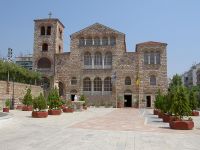Thessalonica
The Greek city of Thessalonica, also Thessaloniki and Salonica, was located in ancient times at the intersection of two major Roman roads, the Ignatia Way from Dyrrhachium (present day Durres in Albania) to Byzantium and another from the Danube River on the way to the Aegean Sea which combined to make it a prominent city on a commercial crossroads. Its location also brought a long association with the Orthodox Christian faith from the time of the Apostle Paul's second missionary journey.
History
While the existence of a settlement at Thessalonica has been traced from before the fourth century before Christ, its relation to Christianity begins with the Apostle Paul's missionary travels in the first century. According to the Acts of the Apostles, Paul visited Thessalonica with Silas and Timothy on his second missionary journey during which he preached the Gospel on three successive Sabbaths, gaining converts from among the Jews as well as many proselytes, Greeks, and socially high women. The majority of Jews of Thessalonica, however, were hostile to his preaching. But, a strong and flourishing church did grow that was composed mainly of Gentiles whom he again visited on subsequent journeys.
Thessalonica remained a stronghold of Christianity during the following centuries, although the city was frequently defended against attacks by Goths, Avars, Slavs, and Bulgarians. In the tenth century the city was captured by the Saracens, and in the twelfth century by the Normans.
Thessalonica was the center of a jurisdictional dispute between the Churches of Rome and Constantinople that lasted from the fourth century until the eighth after the civil dioceses of Dacia and Macedonia were transferred to the Eastern Roman Empire. In order to retain jurisdiction Bishop of Rome Damasus in the late fourth century appointed the Bishop of Thessalonica as his vicar. The issue of jurisdiction remained in dispute until 732 when emperor Leo the Isaurian ruled that all the bishops of Illyria were under the jurisdiction of Constantinople.
Following the Latin conquest of Constantinople in 1204, Thessalonica frequently came under either Latin or Greek control until the city fell to the Muslim Turks during the third decade of the fifteenth century, who then controlled the city until the early twentieth century. Thessalonica is now the second largest city in Greece and the capital of the region of Central Macedonia.
Through these centuries Thessalonica retained a strong Orthodox Christian presence and has been a prominent see led by many notable bishops, including St. Gregory Palamas and Abp. Eustathius.
